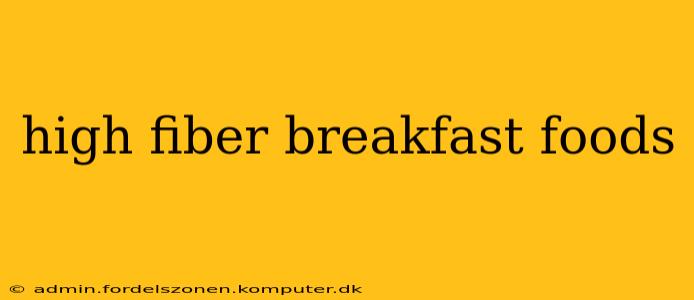Starting your day with a high-fiber breakfast sets the stage for improved digestion, sustained energy, and better overall health. Fiber, a type of carbohydrate the body can't digest, plays a crucial role in regulating blood sugar levels, promoting gut health, and keeping you feeling full and satisfied. But with so many breakfast options available, choosing the right high-fiber choices can be challenging. This comprehensive guide will explore delicious and nutritious high-fiber breakfast foods to help you kickstart your day the healthy way.
What are the Benefits of a High-Fiber Breakfast?
Before diving into specific foods, let's understand why prioritizing fiber at breakfast is so beneficial. A high-fiber breakfast helps:
- Regulate Blood Sugar: Fiber slows down the absorption of sugar into the bloodstream, preventing spikes and crashes in your energy levels. This is especially important for individuals with diabetes or those looking to manage their weight.
- Promote Gut Health: Fiber acts as prebiotic food, nourishing the beneficial bacteria in your gut. This contributes to a healthy microbiome, essential for optimal digestion and overall well-being. A healthy gut is linked to improved immunity and reduced inflammation.
- Increase Satiety: High-fiber foods tend to be more filling, keeping you feeling full and satisfied for longer. This can help you manage your appetite and avoid unnecessary snacking throughout the morning.
- Improve Digestive Health: Fiber adds bulk to your stool, promoting regular bowel movements and preventing constipation. This is crucial for maintaining a healthy digestive system.
- Lower Cholesterol: Soluble fiber, found in certain foods, can help lower LDL ("bad") cholesterol levels, reducing the risk of heart disease.
What are some examples of High-Fiber Breakfast Foods?
Now, let's explore some delicious and versatile high-fiber breakfast options:
Oatmeal:
Oatmeal is a breakfast staple renowned for its high fiber content. A single serving of cooked oatmeal can provide a significant amount of both soluble and insoluble fiber. Experiment with different toppings to add flavor and nutrients – berries, nuts, seeds, and even a drizzle of honey.
Whole-Wheat Toast with Avocado:
Whole-wheat toast offers more fiber than white bread. Pair it with avocado for a healthy dose of monounsaturated fats and additional fiber. Add a sprinkle of everything bagel seasoning for extra flavor.
High-Fiber Cereals:
Many breakfast cereals are fortified with fiber. However, always check the nutrition label to ensure you're choosing a cereal with a high fiber content and low added sugar. Look for cereals made with whole grains.
Berries:
Berries like blueberries, raspberries, strawberries, and blackberries are packed with antioxidants and fiber. Enjoy them on their own, add them to yogurt, or incorporate them into oatmeal or smoothies.
Chia Seeds:
These tiny seeds are nutritional powerhouses. Just a tablespoon of chia seeds can add a significant amount of fiber to your breakfast. Add them to yogurt, oatmeal, smoothies, or even sprinkle them on top of your toast.
Greek Yogurt with Fruit and Nuts:
Greek yogurt is a great source of protein, and when combined with high-fiber fruits and nuts, it creates a balanced and satisfying breakfast. Choose plain Greek yogurt to avoid added sugars.
What are some High-Fiber Breakfast Ideas?
Here are a few breakfast ideas incorporating high-fiber foods:
- Overnight Oats: Combine rolled oats, chia seeds, milk (dairy or non-dairy), and your favorite fruits in a jar the night before. Enjoy a creamy and nutritious breakfast in the morning.
- Smoothie Powerhouse: Blend together fruits (berries, bananas), spinach, Greek yogurt, chia seeds, and a liquid base (milk, juice).
- Whole-Wheat Pancakes or Waffles: Use whole-wheat flour to make pancakes or waffles, adding berries or nuts for extra fiber and flavor.
How Much Fiber Do I Need Each Day?
The recommended daily fiber intake varies depending on age and gender. Consult a healthcare professional or registered dietitian for personalized recommendations. Gradually increasing your fiber intake is recommended to avoid digestive discomfort.
Can I get too much fiber?
While fiber is beneficial, consuming excessive amounts can lead to digestive issues like bloating, gas, and cramping. Increase your fiber intake gradually to allow your body to adapt. Drink plenty of water throughout the day to help with digestion.
Are there any side effects of eating high-fiber foods?
Some individuals may experience digestive discomfort, such as bloating and gas, when they initially increase their fiber intake. This is usually temporary, but if symptoms persist, consult a doctor.
This guide provides a starting point for incorporating more high-fiber foods into your breakfast routine. Remember to consult with a healthcare professional or registered dietitian for personalized dietary advice. By making smart choices, you can enjoy a delicious and nutritious breakfast that fuels your body and supports your overall health.
